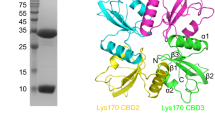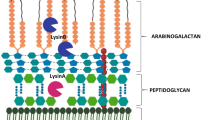Abstract
Mycobacteriophages produce lysins that break down the host cell wall at the end of lytic cycle to release their progenies. The ability to lyse mycobacterial cells makes the lysins significant. Mycobacteriophage Che12 is the first reported temperate phage capable of infecting and lysogenising Mycobacterium tuberculosis. Gp11 of Che12 was found to have Chitinase domain that serves as endolysin (lysin A) for Che12. Structure of gp11 was modeled and evaluated using Ramachandran plot in which 98 % of the residues are in the favored and allowed regions. Che12 lysin A was predicted to act on NAG-NAM-NAG molecules in the peptidoglycan of cell wall. The tautomers of NAG-NAM-NAG molecule were generated and docked with lysin A. The stability and binding affinity of lysin A – NAG-NAM-NAG tautomers were studied using molecular dynamics simulations.












Similar content being viewed by others
References
Clokie MR, Millard AD, Letarov AV, Heaphy S (2011) Phages in nature. Bacteriophage 1:31–45
Wang IN, Smith DL, Young R (2000) Holins: the protein clocks of bacteriophage infections. Annu Rev Microbiol 54:799–825
Borysowski J, Weber-Dabrowska B, Gorski A (2006) Bacteriophage endolysins as a novel class of antibacterial agents. Exp Biol Med 231:366–377
Subramanyam B, Kumar V, Perumal V, Nagamiah S (2010) Phage lysin to supplement phagebiotics to decontaminate processed sputum specimens. Eur J Clin Microbiol Infect Dis 29:1407–1412
Payne K, Sun Q, Sacchettini J, Hatfull GF (2009) MycobacteriophageLysin B is a novel mycolylarabinogalactan esterase. Mol Microbiol 73:367–381
Hassan S, Dusthackeer A, Subramanyam B, Ponnuraja C, Sivaramakrishnan G, Kumar V (2010) Lytic efficiency of mycobacteriophages. Open Syst Biol J 3
Kumar V, Loganathan P, Sivaramakrishnan G, Kriakov J, Dusthakeer A, Subramanyam B, Chan J, Jacobs WR Jr, Paranji Rama N (2008) Characterization of temperate phage Che12 and construction of a new tool for diagnosis of tuberculosis. Tuberculosis (Edinb) 88:616–623
Gomathi NS, Sameer H, Kumar V, Balaji S, Dustackeer VN, Narayanan PR (2007) In silico analysis of mycobacteriophage Che12 genome: characterization of genes required to lysogenise Mycobacterium tuberculosis. Comput Biol Chem 31:82–91
Joseph J, Rajendran V, Hassan S, Kumar V (2011) Mycobacteriophage genome database. Bioinformation 6:393–394
Hatfull GF (2010) Mycobacteriophages: genes and genomes. Annu Rev Microbiol 64:331–356
Altschul SF, Madden TL, Schaffer AA, Zhang J, Zhang Z, Miller W, Lipman DJ (1997) Gapped BLAST and PSI-BLAST: a new generation of protein database search programs. Nucleic Acids Res 25:3389–3402
Larkin MA, Blackshields G, Brown NP, Chenna R, McGettigan PA, McWilliam H, Valentin F, Wallace IM, Wilm A, Lopez R, Thompson JD, Gibson TJ, Higgins DG (2007) Clustal W and Clustal X version 2.0. Bioinformatics 23:2947–2948
Tamura K, Peterson D, Peterson N, Stecher G, Nei M, Kumar S (2011) MEGA5: molecular evolutionary genetics analysis using maximum likelihood, evolutionary distance, and maximum parsimony methods. Mol Biol Evol 28:2731–2738
Bernstein FC, Koetzle TF, Williams GJ, Meyer EF Jr, Brice MD, Rodgers JR, Kennard O, Shimanouchi T, Tasumi M (1977) The Protein Data Bank: a computer-based archival file for macromolecular structures. J Mol Biol 112:535–542
Kelley LA, Sternberg MJ (2009) Protein structure prediction on the web: a case study using the phyre server. Nat Protoc 4:363–371
Gibrat JF, Madej T, Bryant SH (1996) Surprising similarities in structure comparison. Curr Opin Struct Biol 6:377–385
Shindyalov IN, Bourne PE (1998) Protein structure alignment by incremental combinatorial extension (CE) of the optimal path. Protein Eng 11:739–747
Krissinel E, Henrick K (2004) Secondary-structure matching (SSM), a new tool for fast protein structure alignment in three dimensions. Acta Crystallogr D Biol Crystallogr 60:2256–2268
Colovos C, Yeates TO (1993) Verification of protein structures: patterns of nonbonded atomic interactions. Protein Sci 2:1511–1519
Wiederstein M, Sippl MJ (2007) ProSA-web: interactive web service for the recognition of errors in three-dimensional structures of proteins. Nucleic Acids Res 35:W407–410
Cole JC, Nissink JWM, Taylor R (2005) Protein-ligand docking and virtual screening with GOLD. Virtual Screen Drug Disc doi:10.1201/9781420028775.ch15
Pearlman DA, Case DA, Caldwell JW, Ross WS, Cheatham TE, DeBolt S, Ferguson D, Seibel G, Kollman P (1995) AMBER, a package of computer programs for applying molecular mechanics, normal mode analysis, molecular dynamics and free energy calculations to simulate the structural and energetic properties of molecules. Comput Phys Commun 91:1–41
Case DA, Cheatham TE 3rd, Darden T, Gohlke H, Luo R, Merz KM Jr, Onufriev A, Simmerling C, Wang B, Woods RJ (2005) The Amber biomolecular simulation programs. J Comput Chem 26:1668–1688
Huang CC, Couch GS, Pettersen EF, Ferrin TE (1996) Chimera: an extensible molecular modeling application constructed using standard components. Pac Symp Biocomput 1:724
Hatfull GF, Jacobs-Sera D, Lawrence JG, Pope WH, Russell DA, Ko CC, Weber RJ, Patel MC, Germane KL, Edgar RH, Hoyte NN, Bowman CA, Tantoco AT, Paladin EC, Myers MS, Smith AL, Grace MS, Pham TT, O’Brien MB, Vogelsberger AM, Hryckowian AJ, Wynalek JL, Donis-Keller H, Bogel MW, Peebles CL, Cresawn SG, Hendrix RW (2010) Comparative genomic analysis of 60 Mycobacteriophage genomes: genome clustering, gene acquisition, and gene size. J Mol Biol 397:119–143
Bienstock RJ, Skorvaga M, Mandavilli BS, Houten BV (2003) Structural and functional characterization of the human DNA repair helicase XPD by comparative molecular modeling and site-directed mutagenesis of the bacterial repair protein UvrB. J Biol Chem 278:5309–5316
Shulman-Peleg A, Shatsky M, Nussinov R, Wolfson HJ (2008) MultiBind and MAPPIS: webservers for multiple alignment of protein 3D-binding sites and their interactions. Nucleic Acids Res 36:W260–264
Teichert F, Minning J, Bastolla U, Porto M (2010) High quality protein sequence alignment by combining structural profile prediction and profile alignment using SABER-TOOTH. BMC Bioinforma 11:251
Sarvagalla S, Singh VK, Ke Y, Shiao H, Lin W, Hsieh H, Hsu JTA, Coumar MS (2015) Identification of ligand efficient, fragment-like hits from an HTS library: structure-based virtual screening and docking investigations of 2H- and 3H-pyrazolo tautomers for Aurora kinase A selectivity. J Comput Aided Mol Des 29:89–100
Petukh M, Stefl S, Alexov E (2013) The role of protonation states in ligand-receptor recognition and binding. Curr Pharm Des 19:4182–4190
Fogolari F, Brigo A, Molinari H (2003) Protocol for MM/PBSA molecular dynamics simulations of proteins. Biophys J 85:159–166
Bietz S, Urbaczek S, Schulz B, Rarey M (2014) Protoss: a holistic approach to predict tautomers and protonation states in protein-ligand complexes. J Cheminform 6:12
Tiwari G, Mohanty D (2013) An in silico analysis of the binding modes and binding affinities of small molecule modulators of PDZ-peptide interactions. PLoS One 8:e713
Acknowledgments
Ms. Shainaba A Saadhali is a recipient of Senior Research fellowship from Lady Tata Memorial Trust, Mumbai, India. The authors would like to thank Dr. P. Velmurugan, Head of the Department, Department of Biophysics, University of Madras, Chennai, India, for his valuable suggestions. The support and fund provided by National Institute for Research in Tuberculosis (NIRT), Chennai, India, is highly acknowledged. The authors would like to thank Mr. R. Senthil Nathan, NIRT Library, for correcting the figures.
Author information
Authors and Affiliations
Corresponding author
Electronic supplementary material
Below is the link to the electronic supplementary material.
Supplementary Fig. 1
Ramachandran plot. The Ramachandran plot shows that 98 % of the residues are in the most favored and allowed regions of the plot for the modeled gp11 of Che12 (DOC 111 kb)
Supplementary Fig. 2
Conformations of the 31 tautomers. The docked pose of the 31 NAG-NAM-NAG tautomers within the binding site of Che12 gp11 protein. The NAG-NAM-NAG molecule is represented in green color and the binding sites in wire frame and ribbon form (DOC 540 kb)
Supplementary Table 1
GOLD score for the 31 tautomers generated for NAG-NAM-NAG molecule (DOC 45 kb)
Rights and permissions
About this article
Cite this article
Saadhali, S.A., Hassan, S., Hanna, L.E. et al. Homology modeling, substrate docking, and molecular simulation studies of mycobacteriophage Che12 lysin A. J Mol Model 22, 180 (2016). https://doi.org/10.1007/s00894-016-3056-3
Received:
Accepted:
Published:
DOI: https://doi.org/10.1007/s00894-016-3056-3




